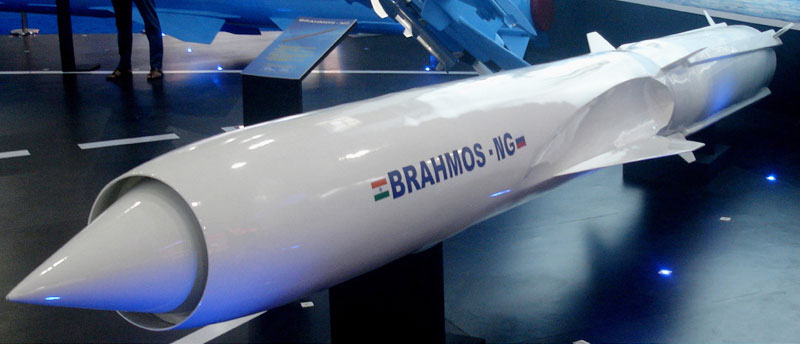BrahMos NG is now ready to be exported and used by the IAF
Smruti D
BrahMos Aerospace Limited, a joint venture between India and Russia, released its latest missile, BrahMos NG (next generation). The missile was first announced in 2014 ahead of Russian President Vladamir Putin’s India visit.

The BrahMos NG is a smaller version of the existing supersonic cruise missile BrahMos. It was created to be deployed on ground-based, aerial, surface and underwater-based platforms. The size of this missile enables it to be launched even from torpedo rooms of submarines. The length of the missile is six metres and diameter 50 centimetres. An official statement ahead of signing the agreement stated that the missile would be ‘difficult’ to counter even for ‘complicated and modern’ anti-aircraft missiles given its size.
Lethal and precise, the BrahMos NG is smaller in size and weight as compared to the original missile. It weighs 1.6 tonnes and is 6 metres long; the earlier version weighed 3 tonnes and was 9 metres long. The missile has a range of 290 km and a speed of up to 3.5 Mach. BrahMos NG has a lesser radar cross section (RCS) compared to the earlier missile, which would make it tougher for air defence systems to locate and engage the target. The new missile will also have an indigenously developed and manufactured seeker. While the earlier missile, BrahMos PJ-10 has mechanically scanned radar, the BrahMos NG will have an AESA radar.
The original range of this missile was 290 km due to limitations of the Missile Technology Control Regime (MTCR). It was after India became a part of the MTCR group, did the range extend to 450 km and can be further extended by 600 km.
BrahMos NG is a multi-platform, multi-target and light-weight weapon system, making it perfect for the battlefield. The reduction in size has happened after mechanical components in the missile were replaced with electrical components.
At the DefExpo 2020, the CEO and MD of BrahMos Aerospace Ltd, Sudhir Kumar Mishra told media outlet Onmanorama that BrahMos NG can be integrated into LCA, LCA MK-II and AMCA. Other aerial systems that it can fit into are MiG-29, Rafael, FGFA and Sukhoi-30MKI. Due to its smaller size, two missiles can be mounted on an LCA and five on a Sukhoi-30MKI. It is estimated that this new version will be ready in the next three to four years and has a great potential for export.
BrahMos NG has variants for every armed force. This is a clear distinction from the earlier BrahMos PJ-10 missile, which, due to its height and weight, could be carried only by the Sukhoi-30MKI. The new missile helps the navy, too, which means that it could fit even in their standard 53 mm torpedo tubes on warships. BrahMos NG is also suitable for the Indian Navy’s Project 75 India (P75I) that was cleared by the Defence Acquisition Council (DAC) in 2019 under the Strategic Partnership model. There is a land-based variant for the Indian Army; a ship-borne and submarine tube-launch variant for the Indian Navy and an air variant for the Indian Air Force (IAF).
The missile was displayed at the Aero India’s 2019 edition on the LCA Tejas aircraft for the first time. It is already operational with the army and navy. The air variant of the missile is going to be lighter than the other two variants.
BrahMos-A
Amidst the India-China border tensions, BrahMos received its first-ever Fleet Release Clearance (FRC) issued by the Centre for Military Airworthiness and Certification (CEMILAC) on 10 June 2020. This means that the IAF squadrons can now make use of the BrahMos missiles during combat missions.
On 22 May 2019 the IAF had test fired the aerial version of the supersonic BrahMos missile from Su-30MKI fighter at the Andaman and Nicobar islands. The 2.5 tonnes air-to-surface missile has a range of 300 km and travels at a speed of Mach 2.8. During the testing, the missile followed the desired trajectory before hitting the land target.
On 22 November 2017, the IAF fired an air-launched 2.8 Mach surface attack missile on a sea target and become the world’s first air force to have tested such a missile. The Su-30MKI aircraft had to undergo changes to be modified for the integration of this missile. The aircraft underwent weight reduction from the original 2.9 tonnes, among other changes. This made integration of the missile a complex process involving mechanical, electrical and software modifications on the aircraft. The software development was undertaken by the IAF engineers while mechanical and electrical modifications were made by Hindustan Aeronautics Limited (HAL).
You must be logged in to view this content.

